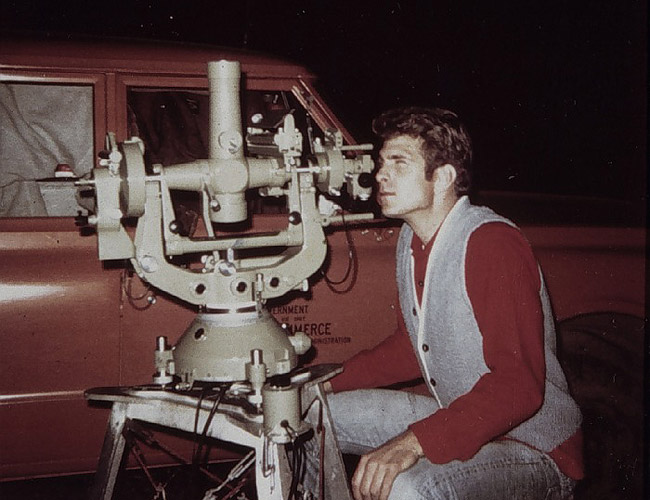 Thomas Jefferson's Theodolite
Thomas Jefferson's Theodolite Hassler's Camp
Hassler's Camp The Great Theodolite
The Great Theodolite Würdemann Six-inch Theodolite
Würdemann Six-inch Theodolite Heliotrope
Heliotrope Micrometer Scale
Micrometer Scale Theodolite Mounted on Water Tank
Theodolite Mounted on Water Tank Seven-inch Repeating Theodolite
Seven-inch Repeating Theodolite C&GS Twelve-inch Theodolite
C&GS Twelve-inch Theodolite Wild T-4
Wild T-4 K&E Theodolite, Parkhurst Design
K&E Theodolite, Parkhurst Design Wild T-2
Wild T-2 Wild T-3
Wild T-3 Topcon GPT-3002LW Total Station
Topcon GPT-3002LW Total Station
Wild T-4
This photo, taken in 1970, shows a Coast Survey field party member using a Wild T-4 Universal theodolite. This theodolite had what was called a "broken telescope," which allowed the theodolite to be used to determine astronomic latitude and longitude.

Image courtesy of Bob A. Pryce.
Initially, astronomic work was done with instruments that looked much like the telescope theodolites of the day. The Coast Survey obtained two Bamberg broken-telescope transits in 1914, so called because the light that enters the telescope is reflected, or "broken," by a prism set at 90° at the intersection of the instrument axis. These broken-telescope instruments were used from 1914 to 1960 to determine astronomic latitude and longitude, with a standard theodolite used for astronomic azimuths. Around 1960, the Bamberg was replaced by the Wild T-4, shown in the photo.
The observing session in Tennessee shown in this image demonstrates one reason why field personnel on "astro" parties had to be night owls. The recorder, not shown, sat in the back of the truck during observations - perhaps to be better protected from mosquitoes!
Historic Reference
Large triangulation projects tend to "twist" due to the accumulation of systematic angular errors. In order to compensate for this, the stars were used to obtain astronomic latitude, longitude, and azimuth. Stars have a celestial latitude and longitude, known as right ascension and declination. A published table called an ephemeris provides necessary celestial information. When combined with observations, it is possible to compute position and azimuth on the surface of the Earth in the same way that geodetic latitude and longitude are calculated.
Stars have one trait that Earth-based geodetic stations do not normally have: they move relative to the observer. Consequently, it is necessary to know exactly when the star was observed in order to know where - its right ascension and declination - the star was at any given time. Like global positioning system observations, astronomic observations require a very accurate chronometer (clock). The development of astronomic surveying was influenced both by changes in the instruments used to observe and the advent of equipment that facilitated accurate time-keeping and communication - first the telegraph, then radio.
- Instrument Shown: Wild T-4 Universal theodolite
- Location: Tennessee
- Manufacture Date: 1944 to 1981 (439 instruments produced)
- Dates of Use: 1960s and 1970s
- Photo date: 1970
Works Consulted
Dracup, J.F. (1940). Geodetic Surveys in the United States 1807-1940. Retrieved July 27, 2006, from: http://www.ngs.noaa.gov/PUBS_LIB/geodetic_survey_1807.html.
Hoskinson, A.J., Duerksen, J.A. Duerksen. (1952). Manual of Geodetic Astronomy, Determination of Longitude, Latitude, and Azimuth. C&GS Special Publication No. 237 (p. 1).
